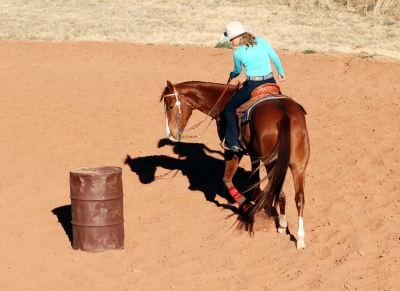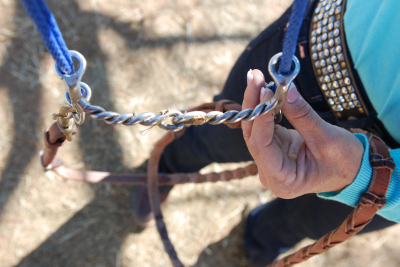Loomis Guidelines
The first rule of using a Loomis gag is to make sure your horse’s teeth have been done properly.
“If you’ve never used one before, you have to make sure your horse’s teeth are right, because that gag bit rolls the cheek right up against the teeth,” Joyce said.
Proper placement in the mouth is a “smile-and-a-half”—between one to two wrinkles in the corners of the mouth.
“I see people hike them up so far to where the horse’s lips are stretched,” Joyce said. “You don’t want the corners of their lips sore. You want to have about a smile-and-a-half. Too little is not good and too much is not good. You want to make sure it’s adjusted right in the corners of the mouth so it’s comfortable.”
Joyce also puts Vaseline on the corners of her horses’ mouths to keep them from getting calluses from the bit, thus losing softness and lightness of contact.

Using the Loomis
The best way to learn to use a Loomis is to ride with someone who uses them a lot. If you have to experiment on your own, Joyce has some rules to ride by.
“When using the Loomis, you work one side of the mouth and then the other, never both at the same time,” Joyce said. “It’s one side of the mouth and then the other. It’s not a one-rein bridle that you can pull straight back with. I always caution parents not to put their kids, who pull straight back, on a horse with a gag bit, because the horse will just open their mouth and move straight forward.”
For example, to teach a horse to stop, Joyce sits her body down, says whoa and works the bit from side to side. This is a slight give-and-take motion on each side. Loomis dislikes using “see-saw” to describe the technique. If what you’re doing with your hands can be described as “see-saw” you’re not being light enough.
Even when working with one side of the mouth, it’s important to remember to give and take as well.
“That’s the best way to use a gag bit—give and take, give and take,” Joyce said. “Give a cue. Reward when they do it. Repetition, reward and correction is a simple way to train horse.”
The principle of give and take is the reason you see horses running with Loomis gags that rarely open their mouth to escape the bit when used properly.
While Loomis gags have been used with all manner of tiedowns, cavesons and such, Joyce prefers to use a German martingale she designed to go with the Loomis if absolutely necessary.
“If I’ve got one that’s flipping its head up, I get the teeth done. If I can’t get what I want done with long hours in the saddle, sometimes I’ll use [a martingale],” Joyce said. “It’s a German martingale. It goes to the side, so you can tip the nose without pulling the head down.”
Soft and Supple
Joyce believes the most important thing a Loomis gag does is give a horse confidence. A confident horse is a relaxed horse. A confident, relaxed horse can become a very supple horse—it all starts in the horse’s mouth.
“You can put it on a horse that’s been frightened and scared, pick up one side of the reins more than the other (ask the horse to give slightly to one side) to where you can barely see the horse’s eye, get in a posting trot, and in 15 minutes, you’ve got a relaxed horse,” Joyce said.
You must first get the No. 1 point—the mouth—secure, Joyce says, to have the opportunity to soften the other four laterals—neck, shoulders, ribs and hips. She also believes a horse that is supple in its neck, shoulders, ribs and hips will automatically get soft in the poll.
“If you soften the laterals, the poll will come in line,” Joyce said. “I don’t believe in tying a horse’s head around. I believe in softening your laterals, and the poll will come down.” {continue to page 3}



